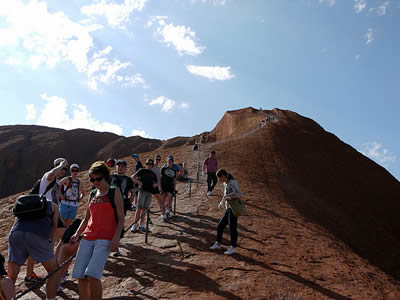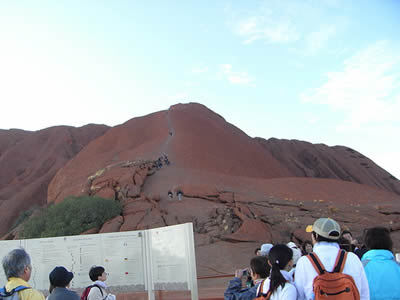This huge rock, in the National Park Uluru-Kata Tjuta is a startling appearance in the desert. It is a sacred site for indigenous peoples of Australia, and can say that transforms into something similar to the thousands of tourists from around the world who visit each year and fall to the spell of his commanding presence and its color changes and especially before that becomes bright red when the sunset strokes.
Photography by Corey Leopold
Origin and location:
Uluru, also known as Ayers Rock, is geologically more than what its name implies: a rock, or say, to be exact, a large sandstone rock formation that is almost in the exact center of Australia, Northern Territory, 430 kilometers southwest of the town of Alice Springs and no less than about 2,800 km from Sydney.
Almost in the exact center of Australia (the so-called Red Center, or Red Centre) and in the heart of National Park Uluru-Kata Tjuta, the rock formation stands as a sort of watchman of nearly 350 feet high (although most part of it is underground) in the middle of a barren and harsh desert, where average temperatures exceed 35 degrees in summer and the rains fail to add up to 100 mm throughout the year.
Photography by daipresents
Heritage:
Even so, this stone monolith in 1987 was declared a World Heritage Site is one of the most visited monuments in the country. So, you’ve created a true «creative industry» or, for some, of kitsch: it can admire airplanes or helicopters flying over, walking many hiking trails, riding on camels, doing tours in the light of dawn or evening, hiring the Cave Hill tour, which promises an indigenous cultural experience, or even enjoying a gala dinner, with tablecloths, crystal glasses and a good Australian wine, right at your feet, while the sacred site is being eaten the shadows of the night.
Also called «the navel of the world», Uluru and Kata Tjuta mount your neighbor have a deep historical and cultural significance to the original inhabitants of the area, the Anangu, for whom this large block of stone represents the crucial point in the intricate web of Tjukurpa routes or Dreamtime (the principle of all creation). Here, on the north side or the Pitjantjatjara people living kangaroo, and in the south, or men yankuntjatjara snake. Among them, around Uluru were fought two great battles, which are still memorialized in songs and ceremonies of ancestral origins.
Aspects of place:
Anangu themselves guided tours in which, besides giving explanations about the flora and fauna and life in the area, tell some of these legends. As Kandju lizard, who came here looking for his lost boomerang, which is represented in the crevices of the rocky surface.
The perimeter of Uluru (of 9.4 km) has many caves and crannies with paintings and engravings, many of them associated with fertility and initiation, that the natives considered of divine origin. Even the nearby representations Wandjina, a god who is much like an astronaut or extraterrestrial, let fly the theories and speculations.
Many of these representations and even areas (such as caves) are sacred to the locals, so visitors are asked to not enter or take pictures. There are unique caves and other unique men and women, and you can not break this rule, because just looking at the paintings in the cave of the opposite sex can lead to terrible punishment by Kandju, Grand Lizard. And even there are signs asking nothing but respect, especially those who arrive with the intention to climb Uluru, «I should not do. It is most important. What is really true is to stop and listen. Be aware of everything around him. Listen and understand, «says one. Still, there are few who insist stubborn and ascend to the top, to see the desert from 348 meters.
Photography by Masao.M
According to the inclination of the sun and the seasons, the surface of Uluru acquires different shades. His most famous image is the sunset, but those lucky enough to admire in one of the few rainy days in the area can see it in a rare silver gray crossed by curious black stripes, which are other than algae growing in small streams.
Tours:
With the three-day ticket to the National Park (U.S. $ 24), it can go both Uluru Kata Tjuta as the nearby (25 km), also called Mount The Olgas, a group of strange formations, also sacred to native peoples. Kata Tjuta means «many heads», and that is one of the impressions that causes this set of peaks, whose maximum height is 546 meters. Legend has it that Wanambi lived up there, the great serpent of the rainbow, down only in the dry season. And parts of the mountain are identified with the Liru (serpent), malu kangaroo man, or pungalunga, cannibalistic giants.
As it was, Kata Tjuta is undoubtedly a necessary complement to any visit to the red desert of Australia and Uluru. And the fantastic legends. The perfect place to heed this warning of the Anangu, and stop to hear. To listen and understand. Or at least try.
Enjoy your trip!
Leave a Reply
You must be logged in to post a comment.



Recent Comments